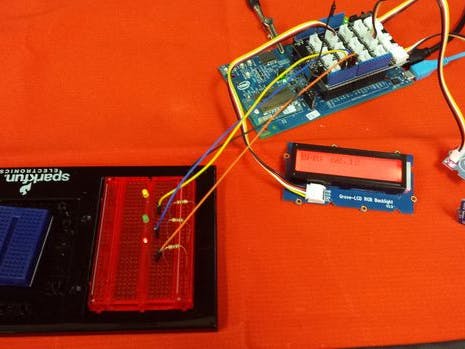The end product is a beat training machine, which the user can program with a custom beat with two different sensory inputs (a touch sensor and a sound sensor (tapping, snapping)). The user can adjust the training tempo using the rotation sensor, and their score is displayed on the lcd screen. The yellow LED flashes in time with the beat, the green and red LED's indicate when the user should trigger the touch sensor and the sound sensor respectively.
The touch and sound sensors can also be put into custom enclosures or traded out for other sensors in order to make the game more interesting.
Step 1: Hardware- Intel Edison
- Static Mat
- Computer
- 2 Mini USB Cables
- 4 Jumper Cables
- Bread Board
- 3 LED Lights (Yellow, Green, Red)
- 4 Pin Cables
- 3 1000 OHM resistors
- Seeed RGB Backlight LCD
- Seeed Rotary Angle Sensor
- Seeed Sound Sensor
- Seeed Touch Sensor
- Plug your Grove base shield into your Edison (doesn’t have to be an Intel Edison - can be an Arduino board).
- Plug jumper cable into port I2C (doesn’t matter which one). Connect other end to RGB Backlight LCD.
- Plug jumper cable into port D8. Connect other end to Touch Sensor.
- Plug jumper cable into port A0. Connect other end to Rotary Angle Sensor.
- Plug jumper cable into port A3. Connect other end to Sound Sensor.
- Plug pin cable into 5V port (located by the I2C ports).
- Plug pin cables into ~3, ~5, and ~6 ports. We will connect these to the yellow, green, and red lights respectively.
- Check bread board diagram and set up accordingly.
- Download code at the end of the page.
- Upload the code into Arduino IDE.
- Upload the code into Edison.
- Practice keeping beat.
- Start making beats.
- Get record deal.
- Become world famous.
- Go to music awards show.
- Jump on stage while awards are being handed out.
- Grab mic.
- “Imma let you finish, but Beyonce had one of the best videos. OF ALL TIME.”
Download the file at the end of the tutorial and copy into your Arduino-Intel IDE (Integrated Development Environment). Upload the code to the Edison Board. Note that there are several customizable parameters appearing in the code, most significantly a String called beat with letters that represent the sensors to be triggered on beat, and a unitsPerBeat which tells how many characters go into a single beat.
Step 4: Lessons Learned- Use a delay in the loop if you are debugging, as this allows you to see everything that happens.
- Leave extra time for a project to account for the time you will spend adjusting and fine-tuning your design.
- Test your designs frequently for usability.











Comments
Please log in or sign up to comment.